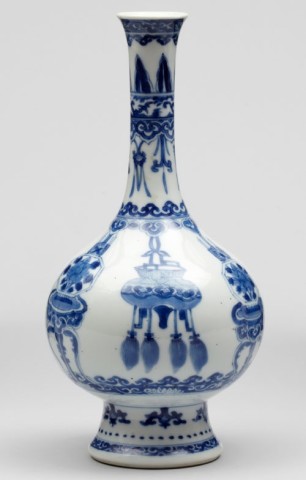Of pear-shaped body gradually emerging into a high cylindrical, slightly everted neck and on a high flaring footring, painted in underglaze blue and decorated on the body with two scaly mythological baby dragons of fierce mien swinging on a tasselled ribbon that hangs from a band of ju-i heads painted around the shoulder of the vase, also hanging from this band further tasselled ribbons tied to a koro censer and another vessel, in between two small tables upon which stands perfume burners with incense sticks, all above a band of ju-i heads and lotus with stylised motifs on a blue ground around the base of the body, the shoulder further decorated with double blue lines, and a further smaller band of ju-i heads, the long neck with pendant tassels hanging from ju-i heads and stiff upright plantain leaves divided by a scrolling border, around the mouth rim a small band of ju-i heads below a finely painted blue band with white flower heads, the foot with further pendant motifs, dots and a white pattern on a blue ground, the recessed base glazed and painted in the centre with a lingzhi.
Literature
For a very similar example in the Topkapu Saray Palace Museum in Istanbul see John Ayers, Regina Kraahl and others, Chinese Ceramics in the Topkapu Saray Museum, Istanbul, London, 1986. Vol III, pl. 2157, p. 1011. Another almost identical example is in the collection of the Keramiekmuseum Princessehof, the Netherlands, no. NO 02204. For a further similar example showing two views see Christine Shimizu et al “L’Odyssée de la Porcelaine Chinoise”, in the Musée national Adrien Dubouche, Limoges, Editions de la Réunion des musées nationaux, Paris, 2003, p 145, pl 83 and a further similar example is in the Metropolitan Museum of Art, New York, no. 29.149.15, bequeathed to the museum by William Rhinelander Stewart in 1929.
See also Christiaan J.A. Jorg in collaboration with Jan van Campen, Chinese Ceramics in the Collection of the Rijksmuseum, Amsterdam, published by Phillip Wilson and the Rijksmuseum Amsterdam, London and Amsterdam, 1997, p 276, pl 319, for the same shape but with a decoration of another mythological beast which he discusses the origin of.

